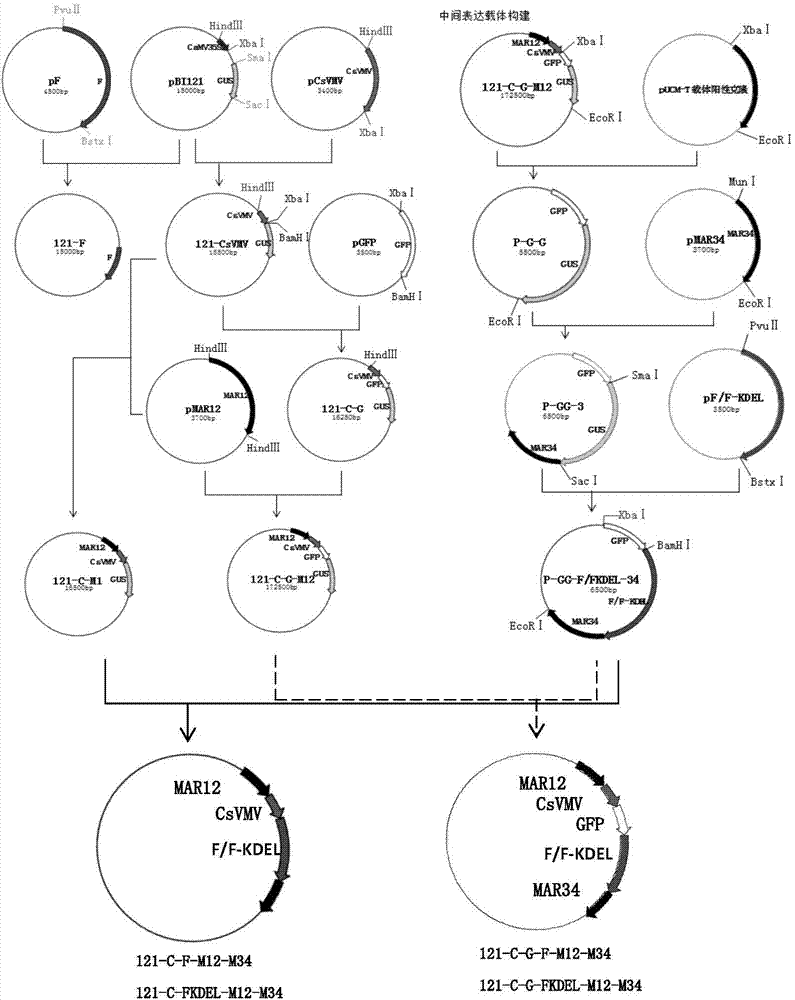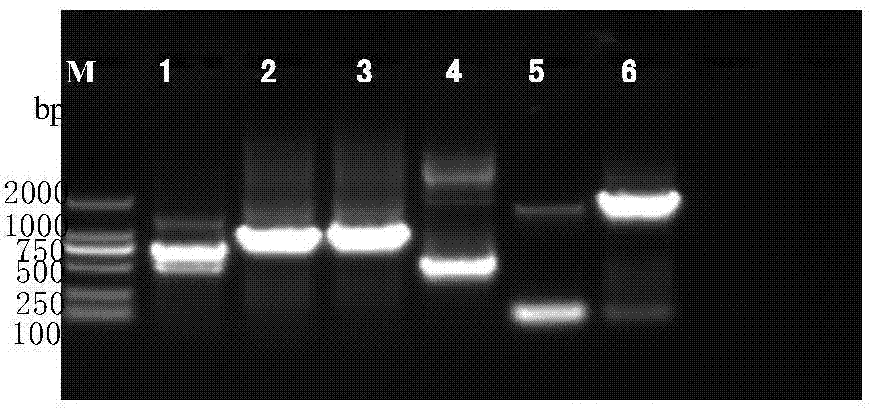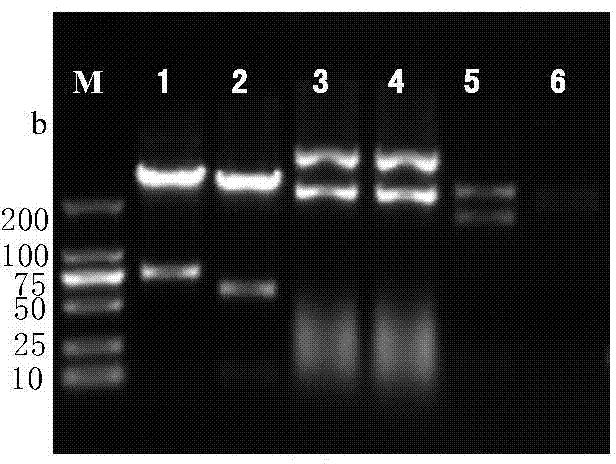Method for constructing peste des petits ruminant transgenic plant vaccine efficient expression vector
A plant expression vector and expression vector technology are applied in the field of recombinant vector construction and can solve problems such as the lack of effective treatment methods for epidemic diseases
- Summary
- Abstract
- Description
- Claims
- Application Information
AI Technical Summary
Problems solved by technology
Method used
Image
Examples
Embodiment 1
[0162] Cloning of target gene and target sequence:
[0163] PCR amplification system (25 μL): 10× buffer 2.5 μL, dNTp (2.5 mM) 2 μL, upstream and downstream primers (20 μM) 0.5 μL each, Taq enzyme (5U / μL) 0.3 μL, template DNA 1 μL, ddH 2 O18.2 μL.
[0164] The PCR amplification program is:
[0165] Cloning of MAR sequence: using pMD-MAR plasmid as a template, use primers MAR12-F, MAR12-R and MAR34-F, MAR34-R to clone respectively; PCR amplification conditions: pre-denaturation at 94°C for 5min, denaturation at 94°C for 60s, Anneal at 55°C for 60s, extend at 72°C for 60s, after 35 cycles, extend at 72°C for 5min, and store the reaction product at 4°C.
[0166] GFP gene amplification: using pHL005 as a template, GFP-F and GFP-R as templates; PCR amplification conditions: pre-denaturation at 94°C for 4 minutes, denaturation at 94°C for 30s, annealing at 58°C for 45s, extension at 72°C for 45s, 30 cycles Afterwards, extend at 72°C for 7 minutes, and store the reaction product a...
Embodiment 2
[0171] The PCR product was connected to the pUCM-T vector by T / A cloning method, and the extracted plasmids were named: pGFP, pMAR12, pMAR34, pCsVMV, pF, pFKDEL. And the corresponding enzymes were digested and verified: pGFP (BamH Ⅰ, Xba Ⅰ) double digestion; 4: pCsVMV (Hind Ⅲ, Xba Ⅰ) double digestion; 2: pMAR12 (Hind Ⅲ) single digestion; 3: pMAR34 (Mun Ⅰ, EcoR Ⅰ) double enzyme digestion; 5: pF (Pvu Ⅱ, Bstx Ⅰ) step-by-step double enzyme digestion; 6: pFKDEL (Pvu Ⅱ, Bstx Ⅰ). For enzyme digestion results, see image 3 .
Embodiment 3
[0173] Construction of plant expression vectors:
[0174] 1. The replacement of the promoter is the construction of the expression vector pBI121-CsVMV ( Figure 4 , 5 )
[0175] The promoter CaMV35S on the expression vector pBI121 was replaced with the CsVMV on the cloning vector pCsVMV to improve the expression efficiency of the vector in plants.
[0176] (1) Respectively double-digest plasmid pBI121 and plasmid with restriction endonuclease HindIII and XbaI
[0177] pUCM-T-CsVMV
[0178] The enzyme digestion system was as follows: 10 μL plasmid, 2.5 μL 10×M buffer, 1 μL each of the two endonucleases, 11.5 μL ddH20, and the total reaction volume was 25 μL. Digest at 37°C for 2 hours, run 1% agarose gel electrophoresis for 35 minutes, purify and recover the large fragment of pBI121 with a DNA gel extraction kit, which is designated as fragment A, and recover the small fragment of pUCM-T-CsVMV, designated as fragment B.
[0179] (2) Connection of Fragment A and Fragment B ...
PUM
 Login to View More
Login to View More Abstract
Description
Claims
Application Information
 Login to View More
Login to View More - R&D
- Intellectual Property
- Life Sciences
- Materials
- Tech Scout
- Unparalleled Data Quality
- Higher Quality Content
- 60% Fewer Hallucinations
Browse by: Latest US Patents, China's latest patents, Technical Efficacy Thesaurus, Application Domain, Technology Topic, Popular Technical Reports.
© 2025 PatSnap. All rights reserved.Legal|Privacy policy|Modern Slavery Act Transparency Statement|Sitemap|About US| Contact US: help@patsnap.com



